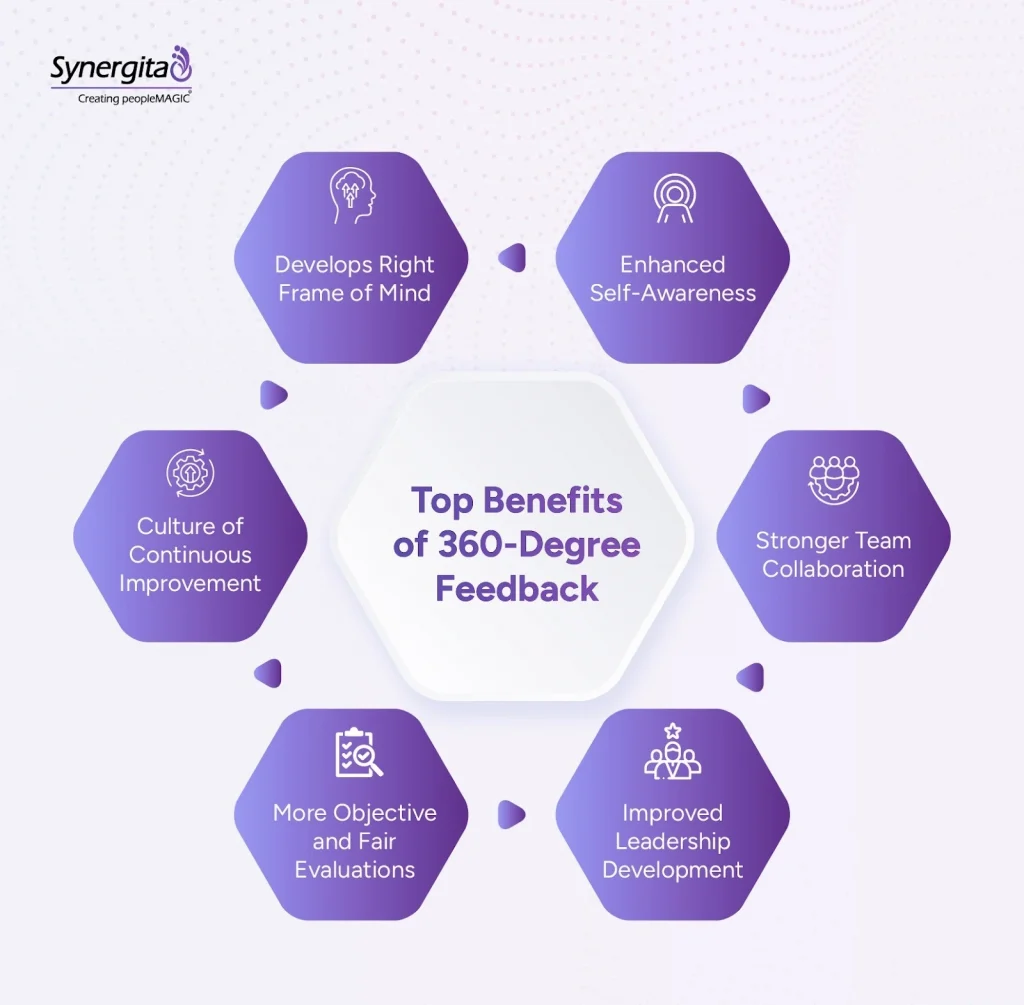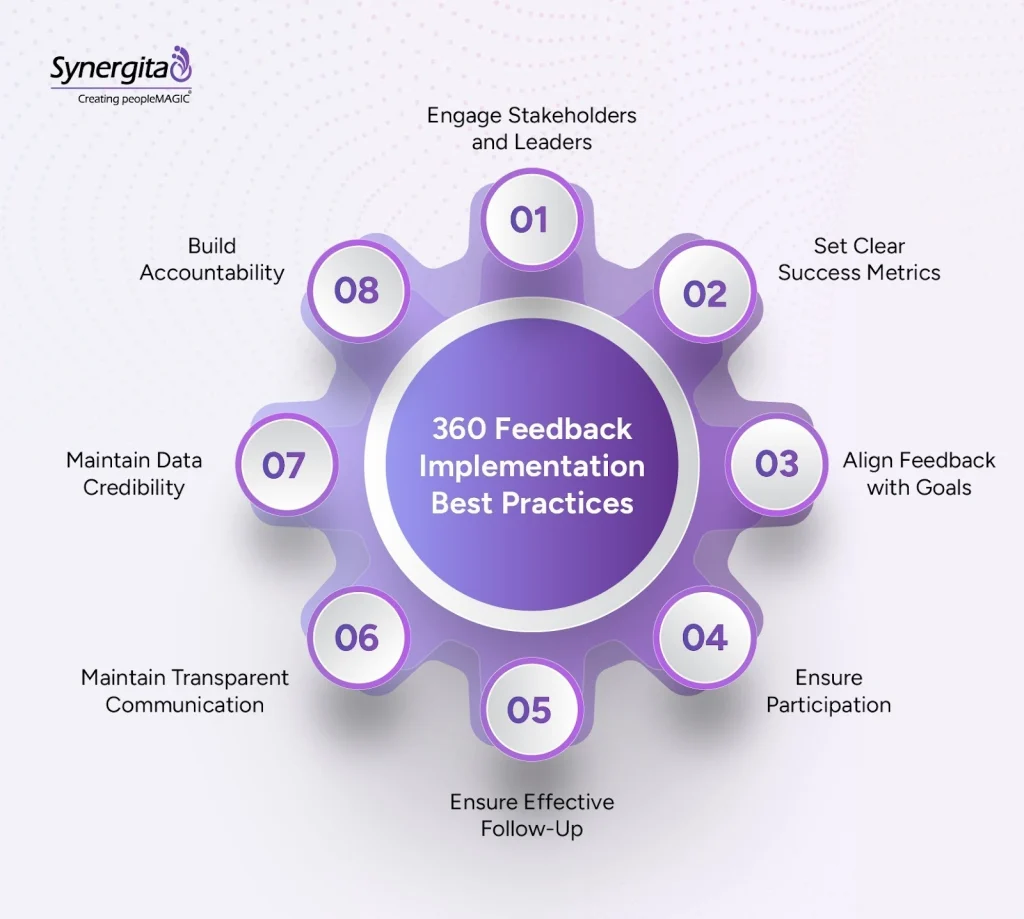Quick Summary
- 360-degree feedback gives a complete view of employee performance by collecting input from managers, peers, and other stakeholders, helping businesses eliminate single-rater bias.
- It builds stronger self-awareness, collaboration, and leadership capabilities to create a culture where continuous improvement becomes part of everyday work.
- Effective implementation of 360-degree feedback requires clear communication, strong leadership support, credible data, and structured follow-up.
- Modern performance management platforms streamline the entire 360 process with automation, analytics, and role-based workflows, helping HR teams to drive greater behavioral improvement with less effort.
The biggest reason performance reviews fail is not bias; it is that they capture only a fraction of the truth. When feedback comes only from one manager, it overlooks how employees actually collaborate, communicate, and influence outcomes across teams.
Modern organizations need a fuller, more reliable view of performance. That is why 360-degree feedback has become a critical part of today’s performance strategies. Gathering insights from managers, peers, and direct reports creates a well-rounded picture of strengths, gaps, and real workplace behaviors.
This guide provides a comprehensive overview of 360-degree feedback benefits, including what it is, why businesses need it, the benefits it offers, and best practices for implementing it.
| Table of Contents 1. What Exactly is 360-Degree Feedback? 2. What Are the Key Benefits of 360-Degree Feedback? 3. Best Practices for Implementing a High-Impact 360-Degree Feedback System 4. How Modern Platforms Streamline 360-Degree Feedback 5. Final Takeaway |
What Exactly is 360 Degree Feedback?
360-degree feedback, or Multi-rater feedback, is feedback on an employee from a variety of stakeholders, including the employee, peers, managers, coworkers, subordinates, vendors, or customers. It helps you get a holistic assessment of the employee’s performance, soft skills, and leadership qualities. A proper understanding of 360 degree feedback allows organizations to use it more effectively for improving employee performance and behavior.
What Are the Top 360 Degree Benefits Business Leaders Should Know?
360-degree feedback delivers comprehensive performance insights and strengthens personal development. The primary benefits include:

1. Enhanced Self-Awareness
One of the key 360 degree feedback benefits is employee self-awareness. Employees understand how others perceive their strengths, weaknesses, and workplace behaviors, just as they can from self-assessment frameworks. This helps employees make more informed decisions around personal development. When individuals see consistent feedback patterns, it becomes easier to acknowledge weaknesses and act on them.
2. Stronger Team Collaboration
Since feedback is collected from peers and team members, employees become more aware of how their behavior impacts others, improving collaboration across teams. This promotes accountability, mutual respect, and a more cohesive work environment.
Suggested Reading: 6 Collaboration Techniques to Improve Team Performance
3. Improved Leadership Development
For employees transitioning into leadership roles, 360-degree feedback offers deep behavioral insights. Organizations can use the results to design coaching interventions, learning programs, and role-specific development paths.
4. More Objective and Fair Evaluations
With multiple reviewers, the risk of single-rater bias is significantly reduced. HR professionals gain a more balanced and accurate understanding of employee performance, even in complex team setups. This makes the 360 degree feedback based performance appraisal approach much more reliable than single-rater evaluations
5. Culture of Continuous Improvement
When implemented regularly, 360 feedback encourages employees to adopt a growth mindset. It supports an ongoing performance improvement culture rather than waiting for annual reviews.
6. Develops Right Frame of Mind
360-degree feedback is not a one-way street. An employee gives feedback to others and receives feedback from them. Thus, it helps in developing the right attitude towards giving and receiving fair and honest feedback.
Best Practices for Implementing a High-Impact 360 Degree Feedback System
Implementing a 360-degree feedback system requires a strategic cultural shift that shapes how employees perceive growth, collaboration, and accountability. Let’s look at the best practices that offer greater depth, operational clarity, and realistic execution steps.

1. Engage Stakeholders and Leaders
A 360-degree program will be successful when leaders at multiple levels believe in its value and actively support its adoption. To build this alignment, you must create a clear narrative about why the 360 is being implemented and how it connects to long-term organizational strategy. Once this clarity is there, it becomes easier to onboard managers, employees, and HR partners into the process.
2. Set Clear Success Metrics
A powerful 360 system is outcome-driven, not activity-driven. Before launching the program, you must establish what success actually looks like, both in terms of process efficiency and behavioral impact. A lack of clarity here leads to confusion, low adoption, and poor results.
You can strengthen program clarity by using specific, measurable indicators such as:
- Survey completion rates within a defined timeframe.
- Completion of development plans by all participants.
- Observable improvements in targeted competencies over 3–6 months.
3. Align Feedback with Goals
A 360-degree feedback system is only effective when the survey content reflects the competencies that actually drive performance in your organization. Using generic templates leads to vague insights, making it difficult for employees to act on the feedback.
When the feedback is built around the role expectations, the results become more meaningful, and employees can see which skills, such as collaboration, communication, decision-making, or strategic thinking, will help them excel in their role.
4. Ensure Participation
Many employees do not view a 360 survey as urgent and postpone completing it. This delay reduces data quality and disrupts the evaluation cycle. You can improve involvement by building a continuous feedback culture within teams.
The key is to create a sense of urgency without making the process feel forced.
To ensure the process flows smoothly, you must shift from explanation to structured action.
A few reliable techniques for improving participation include:
- Setting clear, non-negotiable deadlines supported by automated reminders.
- Adding micro-incentives during the survey phase to maintain momentum.
- Making the survey mandatory for developmental cycles to avoid delays.
5. Ensure Effective Follow-Up
The real transformative power of 360-degree feedback begins after the survey when insights are translated into concrete development steps. Without proper follow-up, the process becomes a one-time event with no meaningful improvement.
Follow-ups must be structured, consistent, and aligned with both individual development and team goals. To make the transition from feedback to development more effective, organizations should introduce structured frameworks such as:
- Post-survey review sessions led by trained managers or coaches.
- Development plans with specific behaviors, timelines, and success measures.
- Regular progress tracking through monthly or quarterly touchpoints.
These steps not only reinforce accountability but also reassure employees that the feedback has long-term value.
6. Maintain Transparent Communication
Trust is the foundation of a successful 360-degree feedback system. Employees want to know how their input will be collected, interpreted, and, most importantly, used. When this clarity is missing, participation drops and feedback becomes less honest.
Effective communication should cover:
- The purpose and intended outcomes of the 360 program.
- The individuals who will have access to the feedback reports.
- The way feedback will influence development or evaluations.
- The measures taken to ensure confidentiality and data security.
7. Maintain Data Credibility
Data quality is critical to the success of a 360-degree feedback program. Weak survey design, poorly written questions, or untrained raters reduce trust in the results.
A credible survey must focus on observable, job-related behaviors. Bracken & Rose highlighted essential conditions for ensuring data credibility. These principles guide organizations in designing surveys that yield accurate, actionable insights.
Here is how to improve credibility:
- Use behavior-based items (e.g., “Provides timely updates” instead of “Is communicative”).
- Ensure raters have real working interaction with the participant.
- Keep rating scales simple and avoid confusing or double-barreled questions.
- Give raters brief guidance to minimize bias.
8. Build Accountability
Without accountability, even the most insightful feedback has limited impact. Employees must understand that the 360 is not about collecting data; it is about applying it.
Managers play a critical role here by guiding and supporting employees in implementing the feedback. Leaders can build accountability by:
- Creating a short development plan immediately after review.
- Discussing progress in monthly one-on-ones.
- Using quick pulse surveys to track behavioral improvement.
How Modern Platforms Streamline 360-Degree Feedback
Manual 360-degree feedback involves survey distribution, report compilation, and follow-up tracking. Handling these tasks manually consumes a significant amount of time and effort. However, a performance management system can help you streamline these processes, reduce administrative effort, and improve data accuracy. Most 360 degree feedback software offers features such as:
- Customizable competency-based questionnaires
- Automated reviewer nominations and reminders
- Confidential, role-based feedback collection
- Data-rich dashboards and visual analytics
- Integration with goal-setting and development plans
By using these tools, HR teams can spend less time coordinating surveys and more time coaching employees, improving behaviors, and sustaining long-term performance.
Final Takeaway
The benefits of 360 degree feedback include long-term employee development, employee self-awareness, leadership development, and stronger team collaboration. Whatever the goal, you should have clarity and use data wisely to improve performance consistently. Moreover, using the right tools is also crucial for the successful implementation of 360-degree feedback.
Leveraging an AI-powered performance management system like Synergita can help you automate the 360-degree feedback process. If you are looking for the right tool to implement 360 feedback, try the Synergita PMS system for free for 7 days and see how it simplifies the entire process.
Frequently Asked Questions
No, 360-degree feedback is a developmental tool that gathers insights from multiple reviewers, while performance appraisals usually evaluate an employee’s performance for a particular period.
Participants in 360-degree feedback usually include managers, peers, and, sometimes, customers or clients who regularly interact with the employee.
Yes, 360-degree feedback should be anonymous, as it encourages honesty and reduces the fear of conflict. However, the level of anonymity can vary depending on organizational culture.
Common competencies in a 360-degree survey include communication, teamwork, leadership potential, decision-making, accountability, and problem-solving.
The common challenges companies face include low participation, poorly designed questions, biased ratings, and a lack of follow-through after reports are generated
Synergita automates survey setup, reviewer selection, reminders, and generates reports, helping HR teams reduce manual work and accelerate the feedback cycle.
Yes, Synergita offers scalable plans, making it suitable for startups, SMBs, and large enterprises that need structured performance processes.


